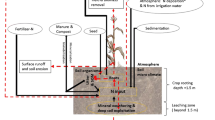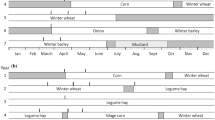Abstract
Agricultural efforts to end hunger in Africa are hampered by low fertilizer-use-efficiency exposing applied nutrients to losses. This constitutes economic losses and environmental concerns related to leaching and greenhouse gas emissions. The effects of NH4NO3 (0, 60 and 120 kg N ha−1) on N uptake, N-leaching and indirect N2O emissions were studied during three maize (Zea mays L.) cropping seasons on clay (Chromic luvisol) and sandy loam (Haplic lixisol) soils in Zimbabwe. Leaching was measured using lysimeters, while indirect N2O emissions were calculated from leached N using the emission factor methodology. Results showed accelerated N-leaching (3–26 kg ha−1 season−1) and N-uptake (10–92 kg ha−1) with N input. Leached N in groundwater had potential to produce emission increments of 0–94 g N2O-N ha−1 season−1 on clay soil, and 5–133 g N2O-N ha−1 season−1 on sandy loam soil following the application of NH4NO3. In view of this short-term response intensive cropping using relatively high N rate may be more appropriate for maize in areas whose soils and climatic conditions are similar to those investigated in this study, compared with using lower N rates or no N over relatively larger areas to attain a targeted food security level.




Similar content being viewed by others
References
ARI (2002) Simplified production factsheets on selected crops grown in Zimbabwe. Agronomy Research Institute, Dept Agric Res Ext Publication, Harare
Bahmani O, Nasab SB, Belizad M, Naseri AA (2009) Assessment of nitrogen accumulation and movement in soil profile under different irrigation and fertilization regime. Asian J Agric Res 3:38–46
Bennett JG (1985) A guide to soil and site description in Zimbabwe. Technical Handbook 6. Chemistry and Soil Research Institute. Dept Agric Res Spec Ser Publication, Harare
Bremner JM, Mulvaney CS (1982) Nitrogen–total. In: Page AL et al. (eds) Methods of soil analysis, 2nd edn. Agron Monogr 9. ASA and SSSA, Madison, WI, pp 595–624
Bruulsema TW, Fixen PE, Snyder CS (2004) Fertilizer nutrient recovery in sustainable cropping systems. In: Armstrong DL (ed) Better crops with plant food. USA, Potash and Phosphate Institute, Norcross, Georgia, pp 15–17
Burneya JA, Davis SJ, Lobella DB (2010) Greenhouse gas mitigation by agricultural intensification. In: Robertson GP, Kellogg WK (eds) Proceedings of the national academy of science of the United States of America, MI, pp 12052–12057
Chikowo R, Mapfumo P, Nyamugafata P, Giller KE (2004) Mineral N dynamics, leaching and nitrous oxide losses under maize following two-year improved fallows on a sandy loam soil in Zimbabwe. Plant Soil 259:315–330
de Klein C, Novoa RSA, Ogle S, Smith KA, Rochette P, Wirth TC et al (2006) N2O emissions from managed soils, and CO2 emissions from lime and urea application. In: Eggleston H, Buendia L, Miwa K, Ngara T, Tanabe K (eds) 2006 IPCC guidelines for national greenhouse gas inventories. Institute for Global Environmental Strategies, Japan
Derby EN, Knighton ER, Montgomery RB (2002) Construction and performance of large soil core lysimeters. Soil Sci Soc Am J 66:1446–1453
FAO (2000) Crop evapotranspiration (guidelines for computing crop water requirements). FAO irrigation and drainage paper no. 56. Food and Agriculture Organization of the United Nations, Rome
Flynn HC, Smith P (2010) Greenhouse gas budgets of crop production–current and likely future trends. International Fertilizer Industry Association, Paris. http://www.fertilizer.org/ifacontent/download/35735/516582/version/1/file/2010_ifa_greenhouse_gas.pdf, Accessed 23 Aug 2010
Goss MJ, Ehlers W (2009) The role of lysimeters in the development of our understanding of soil water and nutrient dynamics in ecosystems. Soil Use Man 25:213–223
Hansen JB, Holm PE, Hansen EA, Hjelmar O (2000) Use of lysimeters for characterisation of leaching from soil and mainly inorganic waste materials. Nordtest Technical Report 473. http://www.nordicinnovation.net/nordtestfiler/tec473.pdf. Accessed 21 Sept 2009
IPCC (2000) Good practice guidance and uncertainty management in national greenhouse gas inventories. National Greenhouse Gas Inventories Publication, Japan. http://www.ipcc-nggip.iges.or.jp/public/gp/bgp/4_6_Indirect_N2O_Agriculture.pdf. Accessed 21 Aug 2010
Kamukondiwa W, Bergstrom L (2007) Nitrate leaching in field lysimeters at an agricultural site in Zimbabwe. Soil Use Man 10:118–124
Kimetu JM, Mugendi DN, Bationo A, Palm CA, Mutuo PK, Kihara J, Nandwa S, Giller K (2006) Partial balance of nitrogen in a maize cropping system in humic nitisol of Central Kenya. Nutr Cycl Agroecosyst 76:261–270
Kuikman PJ, Velthof GL, Oenema O (2003) Controlling nitrous oxide emissions from agriculture: experiences in the Netherlands. In: Proceedings of the 3rd international methane and nitrous oxide mitigation conference. Beijing, China, pp 415–422
Lemaire G, Charrier X, Hebert Y (1996) Nitrogen uptake capacities of maize and sorghum crops in different nitrogen and water supply conditions. Agronomie 16:231–246
Mapanda F, Wuta M, Nyamangara J, Rees RM (2011) Effects of organic and mineral fertilizer nitrogen on greenhouse gas emissions and plant-captured carbon under maize cropping in Zimbabwe. Plant Soil 343:67–81
Mapiki A, Reddy GB, Singh BR (1993) Fate of fertilizer-15 N to a maize crop grown in Northern Zambia. Acta Agric Scand Sect B 43:231–237
Mushiri SM, Chifamba W (1998) Soil survey laboratory methods manual. Chemistry and Soil Research Institute, Dept Agric Res Spec Ser Publication, Harare
Nevison C (1999) Indirect N2O emissions from agriculture. In: Background paper for IPCC expert group meeting on good practice in inventory preparation–agricultural sources of methane and nitrous oxide. IPCC, Wageningen, Netherlands, pp 381–397
Nyamadzawo G, Nyamugafata P, Chikowo R, Chirwa T, Mafongoya PL (2006) Soil and carbon losses under rainfall simulation from two contrasting soils under maize-improved fallows rotation in Eastern Zambia. In: Roose EJ, LAl R, Feller C, Barthes B, Stewart BA, Francis (eds) Soil erosion and carbon dynamics. CRC Press LLC, Boca Raton, pp 197–206
Nyamangara J (2007) Mineral N distribution in the soil profile of a maize field amended with cattle manure and mineral N under humid sub-tropical conditions. In: Bationo A, Waswa B, Kihara J, Kimetu J (eds) Advances in integrated soil fertility management in Sub-Saharan Africa: challenges and opportunities. Springer, The Netherlands, pp 737–748
Nyamangara J, Mugwira LM, Mpofu SE (2000) Soil fertility status in the communal areas of Zimbabwe in relation to sustainable crop production. J Sustain Agric 16:15–29
Nyamangara J, Bergstrom LF, Piha MI, Giller KE (2003) Fertilizer use efficiency and nitrate leaching in a tropical sandy soil. J Environ Qual 32:599–606
Okalebo JR, Gathua KW, Woomer PL (1993) Laboratory methods of soil and plant analysis: a working manual. Tropical soil biology and fertility programme. soil society of east africa technical publication no. 1. Marvel EPZ (Kenya), Nairobi
Piha M (1995) Soil fertility handbook. Department of Soil Science and Agricultural Engineering, Faculty of Agriculture, University of Zimbabwe, Harare 93 pp
Power AG (2010) Ecosystem services and agriculture: tradeoffs and synergies. Phil Trans R Soc B 365:2959–2971
Rao ACS, Smith JL, Papendick RI, Parr JF (1991) Influence of added nitrogen interactions in estimating recovery efficiency of labelled nitrogen. Soil Sci Soc Am 55:1616–1621
Raun WR, Johnson GV (1999) Improving nutrient-use-efficiency for cereal production. Agron J 91:357–363
Reay DS, Edwards AC, Smith KA (2009) Importance of indirect nitrous oxide emissions at the field, farm and catchment scale. Agric Ecosyst Environ 133:163–169
Ritchie SW, Hanway JJ, Benson GO (1992) How a corn plant develops. Special report 48. Iowa State University of Science and Technology. Cooperative Ext Service Ames, Iowa
Seed-Co (1998) Productive farming seed manual 1998/99. Seed-Co Company, Harare
Silva MM, Libardi PL, Fernandes FCS (2009) Nitrogen doses and water balance components at phenological stages of corn. Sci Agric 66:515–521
Smith M (2000) The application of climatic data for planning and management of sustainable rainfed and irrigated crop production. Agric Forest Met 103:99–108
Webster CP, Shepherd MA, Goulding KWT, Lord E (1993) Comparisons of methods for measuring the leaching of mineral nitrogen from arable land. J Soil Sci 44:49–62
Acknowledgments
This study was sponsored through grants from the European Union (NitroEurope Project No. 017841) for which the authors are extremely grateful. We are also grateful for the technical assistance from the Department of Physics (University of Zimbabwe).
Author information
Authors and Affiliations
Corresponding author
Rights and permissions
About this article
Cite this article
Mapanda, F., Wuta, M., Nyamangara, J. et al. Nitrogen leaching and indirect nitrous oxide emissions from fertilized croplands in Zimbabwe. Nutr Cycl Agroecosyst 94, 85–96 (2012). https://doi.org/10.1007/s10705-012-9528-7
Received:
Accepted:
Published:
Issue Date:
DOI: https://doi.org/10.1007/s10705-012-9528-7




